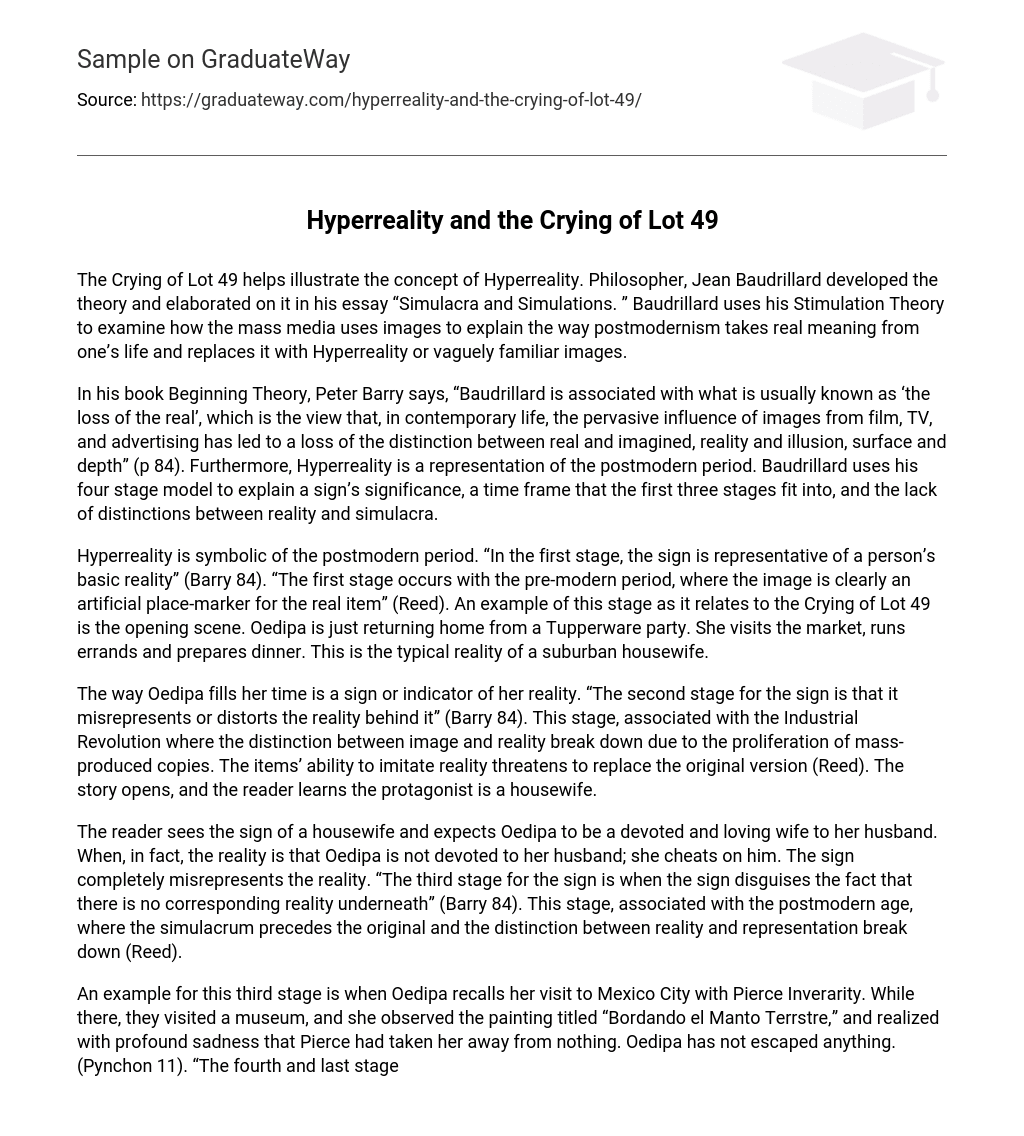The Crying of Lot 49 helps illustrate the concept of Hyperreality. Philosopher, Jean Baudrillard developed the theory and elaborated on it in his essay “Simulacra and Simulations. ” Baudrillard uses his Stimulation Theory to examine how the mass media uses images to explain the way postmodernism takes real meaning from one’s life and replaces it with Hyperreality or vaguely familiar images.
In his book Beginning Theory, Peter Barry says, “Baudrillard is associated with what is usually known as ‘the loss of the real’, which is the view that, in contemporary life, the pervasive influence of images from film, TV, and advertising has led to a loss of the distinction between real and imagined, reality and illusion, surface and depth” (p 84). Furthermore, Hyperreality is a representation of the postmodern period. Baudrillard uses his four stage model to explain a sign’s significance, a time frame that the first three stages fit into, and the lack of distinctions between reality and simulacra.
Hyperreality is symbolic of the postmodern period. “In the first stage, the sign is representative of a person’s basic reality” (Barry 84). “The first stage occurs with the pre-modern period, where the image is clearly an artificial place-marker for the real item” (Reed). An example of this stage as it relates to the Crying of Lot 49 is the opening scene. Oedipa is just returning home from a Tupperware party. She visits the market, runs errands and prepares dinner. This is the typical reality of a suburban housewife.
The way Oedipa fills her time is a sign or indicator of her reality. “The second stage for the sign is that it misrepresents or distorts the reality behind it” (Barry 84). This stage, associated with the Industrial Revolution where the distinction between image and reality break down due to the proliferation of mass-produced copies. The items’ ability to imitate reality threatens to replace the original version (Reed). The story opens, and the reader learns the protagonist is a housewife.
The reader sees the sign of a housewife and expects Oedipa to be a devoted and loving wife to her husband. When, in fact, the reality is that Oedipa is not devoted to her husband; she cheats on him. The sign completely misrepresents the reality. “The third stage for the sign is when the sign disguises the fact that there is no corresponding reality underneath” (Barry 84). This stage, associated with the postmodern age, where the simulacrum precedes the original and the distinction between reality and representation break down (Reed).
An example for this third stage is when Oedipa recalls her visit to Mexico City with Pierce Inverarity. While there, they visited a museum, and she observed the painting titled “Bordando el Manto Terrstre,” and realized with profound sadness that Pierce had taken her away from nothing. Oedipa has not escaped anything. (Pynchon 11). “The fourth and last stage for the sign is that it bears no relation to any reality at all” (Barry 85). Illustrations of this stage can be found throughout The Crying of Lot 49.
The names like Stanley Koteks, Dr. Hilarius, The Paranoids, and Dr. Fallopian are unrealistic and foolish. Pierce Inverarity’s stamp collection that was his substitute for Oedipa is another example of a sign that bears in relation to reality at all. The most obvious example of this fourth sign is at the end of the book when it is finally time for the crying of lot 49 at auction, the event that never happens. The whole book leads the reader to this point only to avoid it altogether. Baudrillard theorizes the lack of distinctions between reality and simulacra originates in several phenomena: contemporary media (television, film, print, and the Internet), the exchange value that places value based on money rather than usefulness, Multinational capitalism, which separates produced goods from original material and the processes used to create them, Urbanization which separates humans from the natural world, and Language and ideology, in which language is used to obscure rather than reveal reality when used by dominant, politically powerful groups” (Reed).
Hyperreality is emblematic of the postmodern movement when art and literature try to “represent the subconscious mind by creating fantastic imagery and juxtaposing ideas that seem to contradict each other” (Encarta Dictionary: English). The theory of Hyperreality is quite complicated and can be difficult for a reader to follow. The whole concept gives the reader a healthy dose of surrealism.
While The Crying of Lot 49 is extraordinarily difficult read, the text is a perfect example of Hyperreality. There always seem to be multiple meanings and the words on the page come alive to create some truly fantastic imagery. The author’s ability to use words to portray an image of Oedipa crying at the art exhibit in Mexico, or his use of words to paint a picture of the frenzied San Narciso makes the reader feel as if he or she is right there watching Oedipa in real time.





